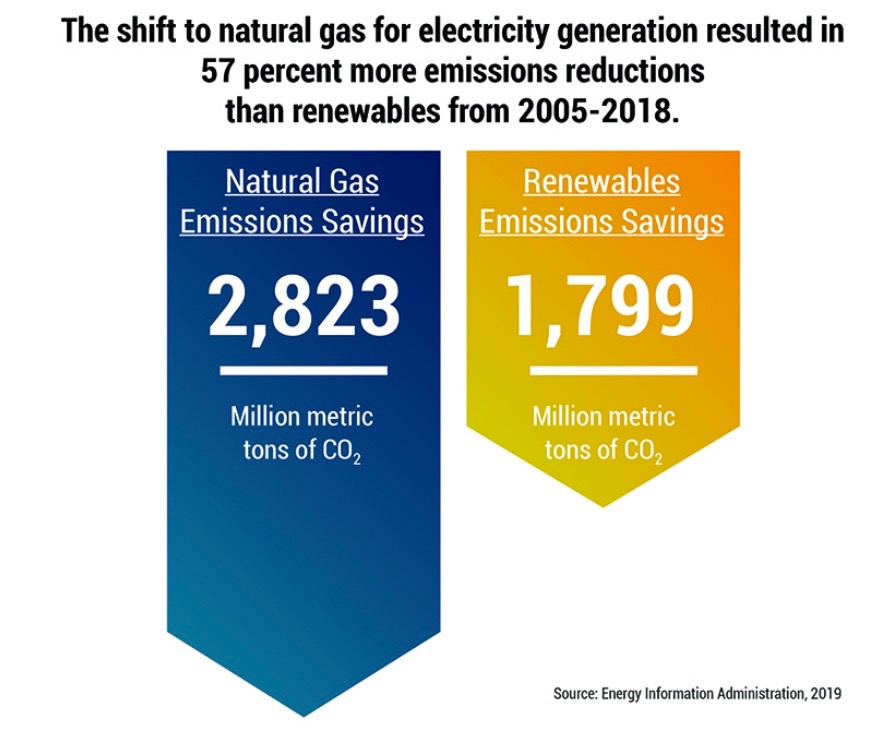Four GHG Reduction Options the ‘Keep It In the Ground’ Movement Opposes or Dismisses
Reducing carbon dioxide (CO2) emissions is priority No. 1 in the global effort to mitigate global warming. So it remains a bit mystifying that a vast majority of climate activists oppose or dismiss several proven CO2 reduction options in favor of a narrow set of deeply flawed policies that would rely almost exclusively on intermittent wind and solar energy to reduce emissions.
The most recent example of the folly of this philosophy is an independent fiscal watchdog report that slams New York state-level version of the Green New Deal, a plan that was heavily lobbied for by “Keep It In the Ground” groups.
Not only did the Citizens Budget Commission (CBC) report criticize New York’s win-and-solar focused plan as being unnecessarily costly for consumers, it noted the plan would be “counterproductive” to emission reduction targets. Why? Because of the state’s focus on renewables over nuclear, natural gas and the kind of “all-of-the-above” approach necessary to not only actually reduce emissions, but do so in a way that won’t devastate the economy.
The report underscores the fact that the “Keep It In the Ground” movement’s push to implement its preferred wind-and-solar-only solutions seem more driven by its war on fossil fuels than a desire to reduce CO2 emissions as much as possible. And amidst all the climate alarm sweeping the country, there remains a fundamental lack of understanding regarding the limitations of wind and solar energy – as well as a general lack of awareness of other energy sources and mitigation options that can be used alongside renewables to more effectively reduce emissions.
IPRB would like to take a few moments to take a closer look at four CO2 emission reduction measures that climate activists either wrongly overlook or outright oppose.
Natural Gas
Increased natural gas use is the No. 1 reason the United States leads the world in CO2 reductions this century. The fuel emits roughly have the carbon dioxide as coal when combusted and has become the top electricity generation fuel in the United States over the past decade.
In fact, the U.S. Energy Information Administration (EIA) has credited fuel switching to natural gas for electricity generation for 60 percent of U.S. power sector CO2 emission savings since 2005. Fuel switching to natural gas is also responsible for 57 percent more CO2 savings in the power sector than renewables during that time, as the following Energy In Depth graphic illustrates.

Overall United States energy-related CO2 emissions have declined 13 percent since 2005. Some “Keep It In the Ground” activists have claimed methane leaks from the natural gas supply chain wipe out natural gas’ climate benefits. But Breakthrough Institute climate scientist Zeke Hausfather has thoroughly debunked this narrative, noting that U.S. CO2 reductions remain in the 10 to 11 percent range since 2005 when the effects of methane leakage are taken into account.
Fuel switching to natural gas is a proven option to reduce CO2 emissions, period, and also serves as a necessary backup to intermittent wind and solar power generation, which cannot be currently stored at the level (and cost effectiveness) necessary to provide baseload power and meet peak demand. Nonetheless, “Keep It In the Ground” activists favor banning hydraulic fracturing – the technology that has made natural gas more abundant and affordable than any time in history.
Natural gas holds even more potential to reduce CO2 emissions when coupled with another technology that “Keep It In the Ground” activists suspiciously oppose.
Carbon Capture and Storage (CCS)
Carbon capture and storage (CCS) – the direct capture of carbon dioxide from power plants, industrial facilities, mobile emission sources and the atmosphere – is a rapidly developing technology that has been identified by the United Nations Intergovernmental Panel on Climate Change (IPCC) as being pivotal to reducing emissions and avoiding the worst impacts of climate change. However, the technology isn’t popular at all among many “Keep It In the Ground” purists, due to the fact that it would prolong fossil fuel use indefinitely.

Interestingly, the primary reasons carbon CCS isn’t already widely used – cost-effectiveness – mirrors one of the key obstacles keeping wind and solar from being implementable on a large-scale basis. But a key breakthrough was made just last month that could go a long way toward solving the CCS affordability issue.
Researchers from the Massachusetts Institute of Technology (MIT) recently published a study detailing how a battery-like device can suck CO2 directly from the atmosphere and store it at a relatively low price ($50-$100 per ton of CO2).
Electro-swing adsorption for high efficiency carbon capture from Sahag Voskian on Vimeo.
Just as importantly, this potential large-scale CCS technology could be applied to automobiles and planes, and could also possibly be used for enhanced oil recovery (EOR), proving not only to be a key tool in addressing climate change but producing the oil the world will need for decades to come.
Even the Natural Resources Defense Council (NRDC) has called CO2-EOR a win-win-win for our environment, energy, and economy. CO2-EOR is currently responsible for 450,00 barrels of oil production per day in the United States and holds the potential to revive mature oil fields such as those that dominate the Illinois Basin.
A pilot CCS natural gas-fired power plant in Texas has also recently been labeled a “great success,” and developers are currently evaluating sites for a commercial version of the plant. Bloomberg also recently reported that a leading CCS company is planning to build a plant in Texas designed to remove one million tons of CO2 from the air annually (equivalent of 250,000 cars) at a cost of $100-$200 per ton removed. If the plant is successful, the company will build hundreds and eventually thousands of similar plants throughout the world. A recent Global CCS Institute report indicates nearly 2,000 such facilities will need to be built by 2040 in order to meet climate change mitigation targets.
Fortunately, a new peer-reviewed study finds there is enough potential underground CO2 storage to meet Paris climate agreement targets. So if costs continue to fall, CCS should be a viable tool to reduce CO2 emissions in the decades ahead.
Nuclear
Nuclear power generation emits no CO2 and currently represents 20 percent of the U.S. power generation mix. Though it doesn’t get nearly as much attention as wind and solar, nuclear energy has far outpaced those technologies in significantly reducing CO2 emissions from the power sector. In fact, as Forbes columnist Michael Shellenberger noted earlier this year that “the only green new deals that have ever worked were done with nuclear, not renewables.”
Shellenberger identifies France and Sweden as the only major nations that have decarbonized their power sectors. France gets 88 percent of its electricity from non-carbon sources, with 72 percent coming from nuclear, another 10 percent from hydro and just six percent from wind and solar. Similarly, Sweden gets 95 percent of its power from non-carbon sources, but 42 percent comes from nuclear, 41 percent from hydro and just 17 percent from wind, solar and other renewables.
Though nuclear energy isn’t perfect (no energy source is) it would certainly seem to be a viable option for a movement that characterizes global warming is an existential threat. However, a fact sheet that was released as part of the Green New Deal rollout calls for nuclear phase-out.
Reforestation
A recent peer-reviewed study shows that increasing the earth’s forests by an area the size of the United States would cut global CO2 by 25 percent. The study’s senior author boasted that his study “shows clearly that forest restoration is the best climate change solution available today” and would return CO2 levels to what they were 100 years ago.
Planting trees is also the most cost-effective CO2 emission mitigation option, with costs of just $15 to $50 per ton of carbon dioxide removed, according to a recent study by the National Academies of Sciences.
However, reforestation has not been prioritized Green New Deal advocates or the “Keep It In the Ground” movement. This could be traced to estimates that a 100 percent conversion to wind and solar energy could require as much as one-third of United States land space to be covered by solar panels and wind turbines. A massive increase in land use for rare earth mineral mining would also be required. Such an undertaking would obviously infringe upon any significant reforestation effort.
Conclusion
To be clear, wind and solar energy will no doubt be a major contributor to any and all efforts to reduce greenhouse gas emissions in the decades to come. However, they are not the panacea that many climate activists and proponents of the Green New Deal and the “Keep It In the Ground” movement make them out to be.
At the same time, a recent New York Times analysis concludes that even assuming aggressive greenhouse gas emission reduction policies are implemented throughout the world “the petroleum industry will have to find about 4.5 million, instead of seven million barrels a day of new production every year.” Even assuming 100 percent compliance with Paris climate agreement targets, 48 percent of global energy will come from oil and natural gas in the decades to come. Put plainly – the world is still going to need a lot of oil and natural gas for a long, long time.
That is why an all-of-the-above approach including natural gas, rapidly improving CCS technologies, nuclear and reforestation is the best path forward. The “Keep It In the Ground” agenda and dogmatic focus on 100 percent wind and solar energy is not.
